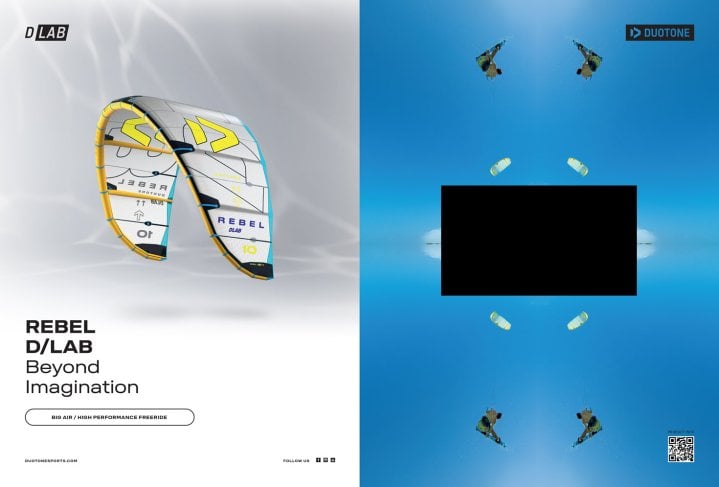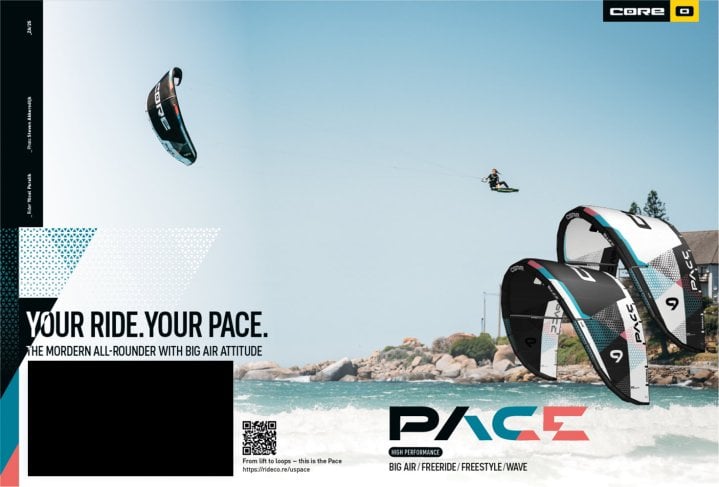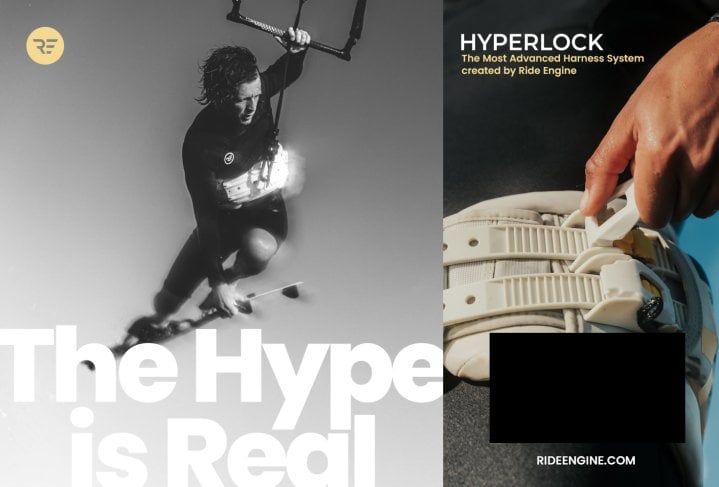
Tech Focus
Issue 82 / Wed 12th Aug, 2020
We’ve adjusted our Tech Focus to feature more brands and more technological innovations from the sport. This issue the F-One Magnet Carbon, North Reach, Eleveight PRS Rails, Mystic Stealth Harness and Flysurfer VMG race kite go under the microscope…
In a new format for the coming issues we’re looking at some of the new products on the market and the technology behind them. In this issue, the new North Reach kite, Mystic’s Stealth Harness, F-One’s new Magnet Carbon strapless surfboard, the PRS Rails from Eleveight and the new VMG from Flysurfer… Enjoy!
Development Never Stops - Eleveight PRS rail design
The 2021 Twin Tip (TT) line is the result of a long development process that took place all around the world. We aimed to challenge the status quo of existing boards to create a product evolution that results in higher and more accessible performance. One of the main features is the innovative Parabolic Rail Shape (PRS) which sets new benchmarks in Twin Tip (TT) rail design.
Franz Schitzhofer, the mastermind behind all our twin tips, has been experimenting with unique rail design theories for a long time as the rail shape is an essential performance parameter for control, maneuverability, power, and speed.
The key idea of the PRS rail is a tucked under edge, a concept which is well known in surfboard shapes, and we adjusted this idea for our TT range.
The PRS rail features a thin rail in the tips, as a thin profile results in better grip and pop during take-offs and landings. The thickness of the rail increases in the foot area and has a tucked-under-edge in the center part. The general concept of a tucked under edge is that the boards sits slightly deeper in water. This creates a much better upwind performance and grip, less spray, and more comfort especially in choppy conditions.
The challenge in the development process was to integrate such a surf-rail in a thin twintip rail. We followed a precise testing process and sampled more prototypes than ever before. We enjoyed every bit of it, and the team is incredibly proud of the result.
-
F-One Magnet Carbon
Could this be the lightest, strongest, most advanced strapless freestyle board ever made? Weighing at a mere 2.3kg for the 4’11” and 2.4kg for the 5’1” version it certainly has the credentials to take the crown. Designed by Charles Bertrand, F-One’s naval architect it was developed with Mitu Monteiro, Matt Maxwell and Simon Joosten.
Using some clever construction techniques and new materials, including a high strength foam core material the team managed to create a thinner board that is actually stronger. F-ONE call the technology Slim Tech Carbon and the thin high strength core is wrapped entirely in a carbon fibre skin, all the layers are carefully laid and vacuum bagged for minimum weight and maximum fibre efiiciency. Creating a thinner, lighter, stronger board with better flex.
It’s not just about the materials either, the Magnet has a totally new shape featureing deep channels on the base and grab rails on the top deck. With an assymetrical rocker line but near symmetrical plan shape the board is designed to be ridden backwards to help you with your spinning tricks and whatever tricks you can dream up the Magnet will be the perfect tool to help you perform.
Available now why not visit your local dealer and get hold of one for a test ride, or just look at the sleek lines and decide to buy one anyway just because it looks so damn good!
-
Tech Focus Flysurfer VMG - velocity made good Interview with Benni Bölli
You’ve long been at the forefront of kite racing design, what makes the new VMG so special compared to the kites that came before it?
The VMG is not only an update from the prior race kites, it is a completely new designed- and redefined foil kite. It is the world’s first Two-Level foil kite with a supported profile technology approved as Formula Kite registered series production equipment.
The biggest difference is the reduced drag with the two-bridle system. The initial idea is to reduce the drag to a minimum by removing 49% of the lines in comparison to a common foil-kite design. The canopy is normally supported by three bridle levels and brake lines that are attached to the trailing edge. The complex bridle line system is controlled by several pulleys to change the profiles camber and angle of attack. The VMG only changes the angle of attack and uses a constantly cambered profile supported by fiberglass rods to generate an efficient airfoil. The highly sophisticated internal construction enables the minimalistic system to work. This innovation is strategically supplementing our future kite designs to tailor them to our performance requirements. The VMG has been tested and tuned by world-class athletes Theo de Ramecourt, Nico Landauer and Florian Gruber in order to reach their dreams. Together we rely on the outstanding quality of the individual highly innovative components and the precise manufacturing process of the production.
It’s a very niche area of the sport, with riders choosing the best gear at the time, does that put additional pressure on the design process in terms of budget and also in the sense you have to have the best kite on the market?
The pressure is high for sure, because the kite is going to be on the market for the next four years and if you don’t have the best kite, you won’t sell a lot so the ROI won’t be as good as it could be. That’s the reason why we have put a lot of effort in the development of the new VMG to make the best race kite in the market.
Can anyone ride the VMG or is it a racers only kite?
Not everyone can race the VMG, only experienced racers and it is specifically designed by and for formula kite racers.
The Soul has proved exceedingly popular amongst the freeriders out there; does the VMG share any of the same DNA?
The VMG doesn’t have any DNA from the SOUL, meaning it has a completely different design. For riders who already have made their first steps on the SOUL and want to go faster, we highly recommend the SONIC, which is our high performance freeride kite- perfect in light wind conditions and for adrenaline-junkies who love massive hangtime.
It’s been recognised by the IKA as registered series production equipment, how does that work with the Olympics, can you keep developing the kite or do you have to settle on this design for the moment?
Benni:
We can already start to design the new kite for the Olympics 2028, but we cannot make any adjustments on the profile of the kite for the Olympic games in 2024. The new VMG is registered by the IKA and we can’t make any changes on the canopy, the only option to tune the kite is on the bridle, so the bridle is open and we can make a new bridle set for example in two years with a new trim and new material. But the design itself is locked until 2024.
The kite is available in a huge range of sizes, how hard is it to get all those designs right, I would assume the 23m is quite different from the 8m?
It is really hard to make a really good small kite and a really good big kite from the same construction-design, so that’s why we developed from the beginning on, 3 different sizes, which are the 9, 15 and 21 and if you have made these sizes working, then you can scale up and down a little bit, but it is not easy to make the big and small sizes feel the same.
Whats next to come from the Flysurfer team in terms of kite development?
There’s definitely something cooking, we have couple of new projects launching soon, don’t worry you’ll be the first one to know. =)
Thanks for taking your time Rou and hope to have a foil kite session soon with you!
-
Mystic Stealth Harness
The harness market has evolved so much in the last few years, it was hard to see where it might be headed. Refinement was arguably the buzzword, but then last year we got a sneak preview of something Mystic had been working on. Kai Lenny is an unlikely champion for the Legend harness they make, it’s a soft harness made of foam that is designed to be light and not absorb water.
Overshadowed by the Majestic X and Majestic it was hard to see where the legend would end up. Well it looks like the designers at Mystic locked the Majestic X and the Legend in a bedroom with a bottle of tequila for the weekend and this is the result. The Mystic Stealth. We’ve had one for a week or so now and can confirm much like its inception it’s the pinnacle of harness porn.
The hard shell back plate combines with the non-absorbent foam to create a supportive, comfortable lightweight harness that looks hard to beat. In fact it looks good enough to eat. Combined with the excellent Stealth Spreader Bar system and it’s the most polished piece of equipment we have seen in the harness game for a long time.
The caveat with any harness of course is that it has to fit you and work with your body, so try one on if you can. It’s rigid, but not so stiff that it doesn’t have a little bit of flexibility to fit different body shapes. What would we change, nothing, it’s about as close to perfect as you can get.
-
The Reach - Interview with Pat Goodman
Is this the best kite you've ever designed?
It's the most versatile kite I've ever made. Whether it's wave-riding, boosting or foiling, the Reach works in any condition you can throw at it. It was nice to have the freedom to design a kite that works in every condition, without having to be so focused on one discipline.
I'm not a hardcore wave or surf rider, I just like to dabble in a bit of everything, so the Reach is my personal go-to kite. I'm also stoked how the Reach sits in the middle of our range, now making the range we offer feel complete. If you're having trouble making a choice of which kite is for you, this is a no brainer; the Reach is your go-to kite.
Can you explain how the design enables the Reach to boost and loop?
The Reach has a slightly higher aspect ratio and flattened arc design for big loft and hangtime. At the same time, it's wider wingtip, and well-balanced bridle helps to maintain a compact steering radius, ideal for kite loops. During a loop, many kites will pause before they climb back up, but the Reach has a smooth, consistent catch that doesn't hesitate to come back around. This is due to the open arc design combined with efficient, powerful profiles.
When it comes to surf, how does the Reach perform?
From the Carve, the Reach has inherited the direct and responsive steering that makes it, so fun to use in the surf. The Reach has tactile handling with light bar pressure and steering impulse for a fast response and tight turning radius.
The neutral static balance improves the drift and helps prevent front and back stall. Both Jalou and Jesse were so excited with the Reach surf characteristics, they both said they just felt right at home in the waves on the Reach.
What is it about the Reach that makes it fly so well in light wind? Is this the go-to kite for foiling in the North line up?
When it comes to foiling and light wind twintip riding, the lightweight 3-strut construction combined with more powerful draft forward profiles helps get you up and going in light wind conditions.
We've kept the weight down by using a small two-ply of canopy along the trailing edge, instead of heavier Dacron materials and minimised heavier reinforcements wherever possible. This way, the steering and performance are optimised, without compromising strength or durability.
In the larger sizes, we've also used a lighter Dacron material in the leading edges and struts, as well as a lighter bladder material.
As the lightest kite in our range, it is perfect for foiling. Its medium aspect ratio swept design, and moderate leading-edge diameter helps the kite release quickly from the water in even the lightest conditions making relaunch a breeze.
So, the Reach is your ultimate desert island kite?
The Reach is the kite I'd choose if I were stranded on a desert island and I could only have one kite. It boosts, loops, foils and surfs - making it the ideal companion for any board in every condition.
Videos
By Rou Chater
Rou has been kiting since the sports inception and has been working as an editor and tester for magazines since 2004. He started IKSURFMAG with his brother in 2006 and has tested hundreds of different kites and travelled all over the world to kitesurf. He's a walking encyclopedia of all things kite and is just as passionate about the sport today as he was when he first started!
























